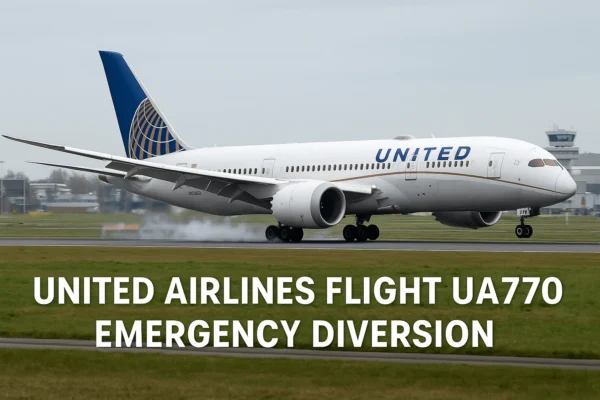Air travel has always been seen as one of the safest ways to move across long distances. Still, every so often, an event reminds passengers just how much work goes into keeping them safe.A notable event occurred when United Airlines Flight UA770 had to make an emergency diversion. This unscheduled landing caught the attention of travelers, aviation enthusiasts, and news outlets alike. Let’s dive deep into what happened, why diversions occur, how passengers were affected, and what lessons the industry can learn from this dramatic event.
Introduction
United Airlines Flight UA770 was scheduled as a routine journey, connecting major destinations on the airline’s network. The flight involved a modern aircraft equipped with advanced navigation and safety systems. Yet, despite technology and preparation, aviation still faces unexpected events. The UA770 diversion shows how airlines and pilots respond to emergencies with speed and precision. It also demonstrates the resilience of the air travel industry when faced with unpredictable circumstances.
What Happened on United Airlines Flight UA770?
The incident unfolded during what was meant to be a smooth journey. Reports show that the crew detected an issue that required immediate attention.
- Scheduled Route: Passengers boarded expecting a direct trip between the planned origin and destination.
- Diversion Decision: Mid flight, the captain and crew opted to divert due to a potential safety risk.
- Landing Location: Instead of reaching the original destination, UA770 landed at an alternate airport prepared to handle the emergency.
Passengers later described how the situation developed. Some recalled the cabin crew remaining calm while others noted the slight anxiety of not knowing what was wrong. Still, the landing was safe, proving how vital pilot training and quick decision-making are in such situations.
Emergency Diversions Explained
What is an Emergency Diversion in Aviation?
An emergency diversion happens when a flight cannot continue to its intended destination due to unexpected issues. These problems may include:
- Mechanical or technical malfunctions.
- Medical emergencies involving passengers or crew.
- Severe weather conditions such as thunderstorms or turbulence.
- Security issues or disruptive passengers.
In the case of United Airlines Flight UA770, the diversion was a precautionary step rather than a response to immediate danger. That choice reflects aviation’s strict safety-first culture.
How Airlines Handle Diversions
When a diversion becomes necessary, coordination is critical:
- Pilots communicate with air traffic control (ATC) to request clearance.
- The airline operations center supports with logistics such as alternate airports.
- The cabin crew reassures passengers while preparing them for landing.
- Ground staff at the diversion airport prepare emergency services and passenger assistance.
These steps ensure safety remains the top priority.
Passenger Experience on United Airlines Flight UA770
Reactions from Travelers
Passengers on UA770 described a mix of emotions. Some were calm, trusting the crew, while others admitted to fear.One traveler shared their experience with a local news station.
“The crew kept their cool and explained everything clearly. That made a huge difference. We landed safely, and looking back, I’m grateful they didn’t take any risks.”
Such feedback highlights the importance of communication during stressful situations.
How United Airlines Assisted Passengers After Landing
After the diversion, United Airlines moved quickly to take care of affected passengers. This included:
- Hotel stays for travelers stranded overnight.
- Meal vouchers for those waiting at the airport.
- Rebooking assistance for passengers needing connections.
The airline’s proactive approach ensured that customer frustration was kept to a minimum, even during a stressful situation.
Safety Protocols and Pilot Training for Emergency Situations
Pilots at major airlines undergo rigorous training for scenarios just like the UA770 diversion. Training involves:
- Flight simulator sessions replicating real emergencies.
- Scenario based decision making exercises.
- Team coordination drills with cabin crew.
The FAA (Federal Aviation Administration) also enforces strict rules on diversions, ensuring that decisions prioritize passenger and crew safety above convenience.
Similar Past Incidents Involving United Airlines Flights
Previous United Airlines Diversions
This isn’t the first time United has faced an emergency diversion. Other flights in the past have been rerouted due to sudden medical emergencies or unexpected mechanical problems. Each case reinforces the idea that diversions, while inconvenient, are a necessary part of safe aviation.
Industry Wide Examples
United is not alone in this. Airlines across the globe have seen similar events:
- British Airways Flight BA327 once diverted due to smoke in the cabin.
- Delta Flight DL203 was rerouted after a technical warning light came on.
These examples show that diversions are part of aviation’s built-in safety net rather than signs of systemic failure.
Insights Gained from the Emergency Diversion of United Airlines Flight UA770
The UA770 emergency landing offers several lessons:
- Preparedness matters: Airlines must always train for the unexpected.
- Communication calms passengers: Clear updates reduce anxiety.
- Safety outweighs schedules: Delays and diversions are minor compared to risks.
For passengers, the lesson is simple: trust the crew, as their training equips them to make life-saving decisions.
Quick Reference Table: UA770 Emergency Diversion Facts
| Detail | Information |
| Airline | United Airlines |
| Flight Number | UA770 |
| Incident | Emergency diversion |
| Reason | Precautionary safety concern |
| Impact | Safe landing at alternate airport |
| Passenger Support | Hotels, meals, rebooking assistance |
Frequently Asked Questions (FAQ)
Why was United Airlines Flight UA770 diverted?
The flight diverted due to a precautionary safety concern detected mid-flight.
How often do emergency diversions happen?
Globally, diversions occur on less than 1% of flights. They’re rare but crucial when needed.
Are passengers compensated after a diversion?
Compensation varies. Often, airlines provide meals, hotels, and rebooking options.
Is flying still safe after such incidents?
Yes. Diversions prove the system works.Flying continues to be one of the safest ways to travel.
Conclusion
The emergency diversion of United Airlines Flight UA770 highlights how safe and flexible today’s aviation can be.While the incident disrupted plans, it also showed how quickly airlines can respond to protect lives. Diversions may be inconvenient, but they’re part of the reason flying remains one of the most reliable ways to travel.
By examining UA770, passengers gain a better understanding of why diversions happen and how they ultimately serve one purpose: safety first, always.



